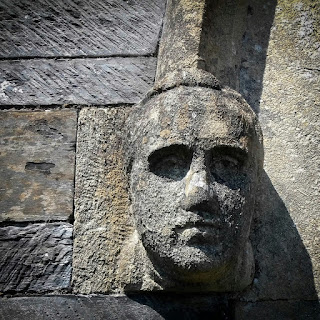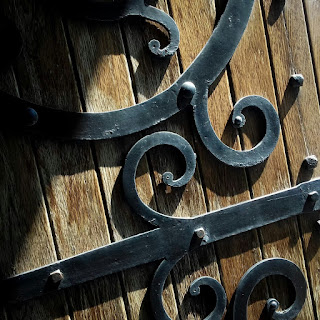No products in the cart.
Return To ShopCardigan/Aberteifi – Castle and Historic Church
As I mentioned in my previous post, I was in Wales a few weeks ago, visiting my Dad. While I was there, I visited three castles and a few old churches. I’m not sure quite how ‘Gothic’ in the spooky sense of the word this is, but it is Gothic in the architectural sense. It’s hard to feel spooky on a day with such bright sunshine – glorious for many, but too warm for me!
This post does include a spider photograph, so if you’re averse to spiders, then don’t scroll past the ornate door. I have put it as the last photograph so you can still appreciate the others without having to look at spiders.  Restored curtain wall, Cardigan Castle. Photo by me.
Restored curtain wall, Cardigan Castle. Photo by me.
 Restored curtain wall, Cardigan Castle. Photo by me.
Restored curtain wall, Cardigan Castle. Photo by me.Cardigan/Aberteifi is on the River Teifi, and we went there to visit the indoor market, and have a look around. I had had been there before, and knew it had a castle, and it was restored in 2014 (which I had read about). The first time I had been to Cardigan was before that, and while I think local council owned it at the time, it was in disrepair after having been neglected by its previous owner and inhabitant for many decades. Unfortunately, while the entrance fee was modest, I didn’t have enough money on me, so I didn’t get to go inside the grounds. From what I gather, most of the buildings on site are later, but it has nice gardens, and I was hoping to at least look at the gardens, but it was not to be. I did take a couple of photographs of the exterior, however. Secondary wall, embankment, and then primary wall with tower…And a much later additional house/cottage, affiliated with the castle. Photo by me.Another gem was a rather lovely medieval church that has been extended several times over the centuries. The church is The Priory Church of Our Lady of Cardigan (I don’t know what that is in Welsh, although I did read it and I’ve since forgotten it). It is in a very beautiful graveyard, and next to a hospital but also next to a busy road. I did take some exterior photographs, but they didn’t turn out very well. I apologise for no good overview photographs. My partner Raven also took some nice photographs, so with his permission, I have included those too.
Secondary wall, embankment, and then primary wall with tower…And a much later additional house/cottage, affiliated with the castle. Photo by me.Another gem was a rather lovely medieval church that has been extended several times over the centuries. The church is The Priory Church of Our Lady of Cardigan (I don’t know what that is in Welsh, although I did read it and I’ve since forgotten it). It is in a very beautiful graveyard, and next to a hospital but also next to a busy road. I did take some exterior photographs, but they didn’t turn out very well. I apologise for no good overview photographs. My partner Raven also took some nice photographs, so with his permission, I have included those too.
 Secondary wall, embankment, and then primary wall with tower…And a much later additional house/cottage, affiliated with the castle. Photo by me.Another gem was a rather lovely medieval church that has been extended several times over the centuries. The church is The Priory Church of Our Lady of Cardigan (I don’t know what that is in Welsh, although I did read it and I’ve since forgotten it). It is in a very beautiful graveyard, and next to a hospital but also next to a busy road. I did take some exterior photographs, but they didn’t turn out very well. I apologise for no good overview photographs. My partner Raven also took some nice photographs, so with his permission, I have included those too.
Secondary wall, embankment, and then primary wall with tower…And a much later additional house/cottage, affiliated with the castle. Photo by me.Another gem was a rather lovely medieval church that has been extended several times over the centuries. The church is The Priory Church of Our Lady of Cardigan (I don’t know what that is in Welsh, although I did read it and I’ve since forgotten it). It is in a very beautiful graveyard, and next to a hospital but also next to a busy road. I did take some exterior photographs, but they didn’t turn out very well. I apologise for no good overview photographs. My partner Raven also took some nice photographs, so with his permission, I have included those too.  Photograph by myself. Gravestones in rows through yew trees.The graveyard is mostly older graves, although I did not go around and get a particularly good average for the estimate age – looked like mostly 1700s and 1800s gravestones.They are almost all made of the same sort of grey stone as the church and the castle, and most are a slab given a roughly arched shape with text – not like some of the Protestant chapel yards, full of urns and obelisks, or a chapel on a hill we visited, which had a much wider variety of stones. (Unfortunately I accidentally deleted many of the photos of that particular chapel! )
Photograph by myself. Gravestones in rows through yew trees.The graveyard is mostly older graves, although I did not go around and get a particularly good average for the estimate age – looked like mostly 1700s and 1800s gravestones.They are almost all made of the same sort of grey stone as the church and the castle, and most are a slab given a roughly arched shape with text – not like some of the Protestant chapel yards, full of urns and obelisks, or a chapel on a hill we visited, which had a much wider variety of stones. (Unfortunately I accidentally deleted many of the photos of that particular chapel! ) Photo by Raven. This is the far corner of the graveyard. All along the back wall are grave-stones laid vertical, with the climbing plants sort of taking over in places. I don’t know if they are memorials from plots that were re-used, or if this is just where fallen-over stones got placed, or if there were just a lot of people buried along the wall. I also think this photo goes to show what a bright and sunny day it was – very hot, a few wispy white clouds, and scorching brightness. Personally, I found it too hot; I overheat easily and get sun-burnt just as easily, so I prefer cloudier, cooler days. Some people love the sun, but I have to hide under hats, long-sleeved floaty clothes and lots of sun-screen.
Photo by Raven. This is the far corner of the graveyard. All along the back wall are grave-stones laid vertical, with the climbing plants sort of taking over in places. I don’t know if they are memorials from plots that were re-used, or if this is just where fallen-over stones got placed, or if there were just a lot of people buried along the wall. I also think this photo goes to show what a bright and sunny day it was – very hot, a few wispy white clouds, and scorching brightness. Personally, I found it too hot; I overheat easily and get sun-burnt just as easily, so I prefer cloudier, cooler days. Some people love the sun, but I have to hide under hats, long-sleeved floaty clothes and lots of sun-screen.  Dead Tree. Photo by Raven I’m not sure what kind of tree this was when it was alive. There were plenty of yew trees, but yews are poisonous to other plants, so I doubt that there would be other plants growing from it if it were a yew. The tree stump felt almost sculptural, and its timbers bleached grey-white seemed fitting with the stone and almost skeletal itself.
Dead Tree. Photo by Raven I’m not sure what kind of tree this was when it was alive. There were plenty of yew trees, but yews are poisonous to other plants, so I doubt that there would be other plants growing from it if it were a yew. The tree stump felt almost sculptural, and its timbers bleached grey-white seemed fitting with the stone and almost skeletal itself.  Grave with ornate carving. Photo by Raven.This gravestone near the entrance was interesting – it had some sort of crest surrounded by a laurel wreath or other foliage, but it has suffered the ravages of time – the central design, presumably a monogram, is pretty much illegible, and any motto or similar on the banner beneath the leaves has long since de-laminated. I think perhaps the topmost leafs have lost some mass, too. It’s interesting to see a headstone carved in the shape of a Dutch gable, too.
Grave with ornate carving. Photo by Raven.This gravestone near the entrance was interesting – it had some sort of crest surrounded by a laurel wreath or other foliage, but it has suffered the ravages of time – the central design, presumably a monogram, is pretty much illegible, and any motto or similar on the banner beneath the leaves has long since de-laminated. I think perhaps the topmost leafs have lost some mass, too. It’s interesting to see a headstone carved in the shape of a Dutch gable, too.  Architectural salvage. Photograph by Raven.
Architectural salvage. Photograph by Raven.
I’m not sure which part of the building this detail came from – I couldn’t even figure it out by looking at it – it’s some part of some Gothic details, but it’s also a broken jigsaw piece of architectural history. Raven took this photograph of it – I guess it looks sort of abandoned in this corner of the porch, but really it’s a sign that someone’s put it there so it doesn’t get discarded. I don’t know where on the building it used to belong – perhaps part of something that has since been altered, so it can’t go back – but whatever it was, it is put there where it is not forgotten. It’s almost on display.
 Monk. Photograph by me
Monk. Photograph by me
This monk’s head terminates the arch over the porch. It looks like one of the more recent additions to the church. From what I gather of the church’s history, I think at some point it was connected to a monastery as well as a priory (I’m really no expert on this), which I guess is why they used monks as a decorative motif. There’s one at both ends of the archway, looking solemnly upon all those who enter the church. I don’t know if they are representative of specific people or not.
 Ornate ironmongery. Photograph by me.
Ornate ironmongery. Photograph by me.
Both Raven and I admired the ornate doors – I don’t know how old they are, perhaps Victorian, perhaps earlier, but they have the most fabulous swirling ironwork on them. I have a thing for doors and windows – maybe it’s liminality of them. I also really appreciate when something that doesn’t need to be ornate gets an artistic treatment. Plenty of church doors have much simpler hinges, some have fancier, but it’s nice to see something like this. Someone put enough time, money and effort in for this to be not just an ordinary door – probably several people; someone to make the timbers into a door, someone (or some people) to do the metalwork, someone who designed it, someone who paid for it… Someone who checked that it would fit in the aperture of the door frame! It’s not as common these days, to have such things made, and I think we’re losing out.
There are several stained glass windows in the church – framed by stone tracery that looks very, very old indeed – but maybe not as old as the apertures in the walls, as they look like they once had larger arches and arched tracery rather than arches in rectangles. I don’t know exactly how many phases of construction and alteration there have been (I counted at least 5) but it’s got so much history built into the walls. It was really quite fascinating.  Spider, photograph by me.
Spider, photograph by me.
 Spider, photograph by me.
Spider, photograph by me.I really like spiders. Raven, not so much. I saw this spindly one on its thread in the porch window.

